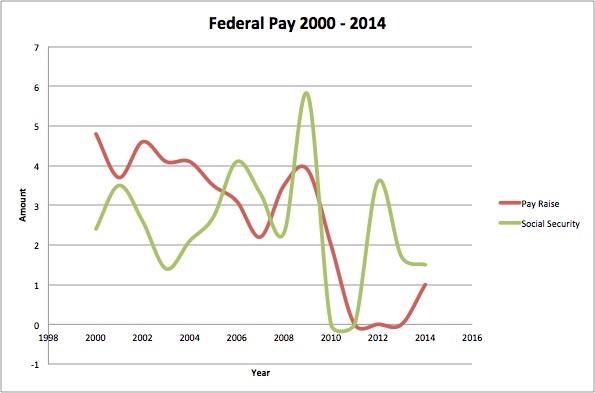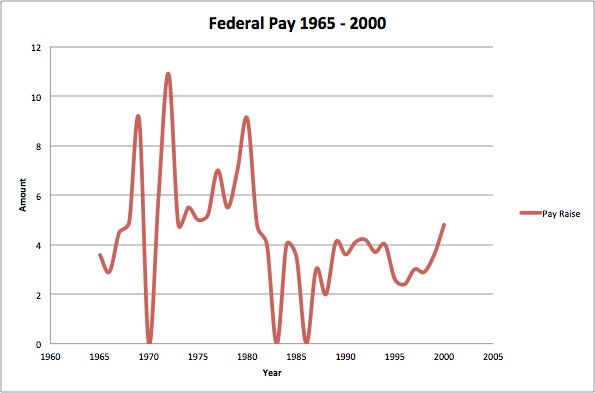From comments from readers and the actual numbers, federal employees are unhappy about a 1% raise in 2015. They are also unhappy with a pay freeze for the past three years and many were also unhappy about the 2% average pay raise in 2010 as well.
We also see comments from those who think retirees get a better deal with Social Security cost of living increases than active federal employees receive. As you can see from this chart, it depends on the year as to which group fares better. The green line shows increases for Social Security and the red line displays federal pay increases per year.
The cost of living (COLA) for Social Security and federal retirees is determined by a pre-determined formula based on the rate of inflation. An annual pay raise for federal employees is a political decision based, in part, on pay comparability with the private sector although no satisfactory method of determining the differential has been reached. It is an understatement to note that there is significant disagreement about whether the amount of pay received by federal workers compared to the private sector his too high or too low.
Despite the debate, it is clear federal employees have not received much in the way of pay raises under the Obama administration. The official rate of inflation has been very low, unemployment has been high, the number of “discouraged workers” has been increasing, and the federal deficit has grown dramatically while economic growth has been lower than normal when recovering from a recession. The ratio of debt to the Gross Domestic Product (GDP) was 99% in 2013 and the national debt was about $17 trillion. We are one of the world’s largest debtor nations.
As readers will see from this chart depicting federal employee pay raises from 1965 to 2000, there have been times where federal workers received pay raises of more than 10% in a year (1972) and years in which the raise was almost 10% (1969 and 1980). It may surprise some to learn that the inflation rate in 1968 was only 4.27% and 5.46% in 1969. The inflation rate in 1971 and 1972 was also not as high as the salary increase for federal employees.
In 1969, Richard Nixon was president serving the first year of his term. The national debt was $354 billion and the debt to gross domestic product (GDP) ratio was 34% (compared to about 99% in 2013). America was one of the world’s largest creditor nations. There was plenty of room in the budget for a pay increase for federal employees. In 1972, Nixon easily won re-election and federal employees received a pay increase of 10.9%. President Nixon’s action taking the U.S. off of the gold standard was a factor leading to significant inflation of more than 11% in 1974.
You will also see that there was not a federal pay raise in 1983 when unemployment peaked at 10.8%. The last year in which there was no federal pay raise, until the pay freeze that was initiated in 2011, was 1986.
The period from 2011 – 2014 (and probably will include 2015) will be the longest stretch of no or very small federal employee pay raises going back to 1945.
No doubt, there are many reasons for the small pay raises. High unemployment, low inflation, massive national debt and large federal budget deficits certainly play a role in the political decision not to grant larger pay raises. Other reasons may include the fact that Republicans now see federal employee unions as strong supporters of Democratic candidates and are not inclined to support significant pay raises to support political opponents.
Readers have voiced their own views as to why there has been a pay freeze and low pay raises for the past few years. In formulating your own opinion, it may be helpful to put the current situation into an historical perspective of how the raises have been implemented over several decades.



